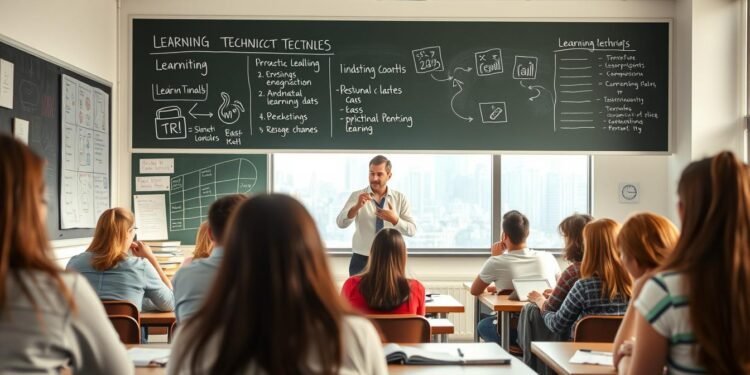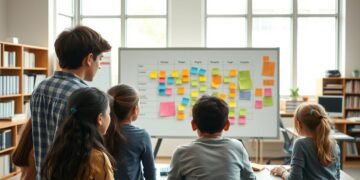Have you ever wondered why some people seem to master new skills effortlessly while others struggle to retain information? The secret lies in understanding the art of learning itself. Learning how to learn is a meta-skill that can transform your personal and professional growth.
During my time in medical school, I discovered the power of accelerated learning. Balancing rigorous studies with entrepreneurial ventures required strategies that maximized efficiency. Books like Make It Stick and Scott Young’s Ultralearning became my guides, helping me carve out time for content creation and team management.
Today, these techniques are more relevant than ever. From mastering new skills to managing teams, the ability to learn faster is a game-changer. Abraham Lincoln once said, “Give me six hours to chop down a tree, and I will spend the first four sharpening the axe.” Preparation and strategy are key to success.
Key Takeaways
- “Learning how to learn” is a critical meta-skill for growth.
- Accelerated learning can help balance multiple responsibilities.
- Modern applications include skill development and team management.
- Science-backed techniques address common learning challenges.
- Mastering learning strategies offers lifelong benefits.
Introduction: The Power of Learning How to Learn
Efficient learning is the cornerstone of success in today’s fast-paced world. Whether preparing for exams, building a business, or pursuing creative goals, mastering this skill can make all the difference. The brain is remarkably adaptable, thanks to neuroplasticity, which allows it to form new connections and acquire skills throughout life.
Not all learning methods are created equal. Passive approaches, like rereading notes, often lead to poor retention. Studies show that college students who rely on these methods retain only 20% of the material. In contrast, active techniques, such as self-testing, can boost retention rates significantly.
Consider the case of a medical student who improved her GPA while launching a YouTube channel. By adopting active learning strategies, she managed her time effectively and achieved both academic and personal goals. This highlights the transformative power of efficient learning.
Poor learning habits come at a cost. On average, individuals waste hundreds of hours annually due to ineffective methods. The Ebbinghaus Forgetting Curve explains why we forget information quickly without reinforcement. However, spaced repetition can combat this, improving recall by up to 73%.
A UNC Chapel Hill study found that active learning techniques increase retention rates by 50% compared to passive methods. By understanding and applying these principles, you can unlock your full potential and achieve lasting success.
1. Sharpen the Axe: Prepare Your Mind for Learning
Setting the stage for learning can dramatically improve outcomes. The metaphor of “sharpening the axe” highlights the importance of preparation. In modern cognitive science, this means creating the right conditions for your brain to absorb and retain information effectively.
An MIT study found that proper preparation can accelerate skill acquisition by 40%. This applies to various fields, from language learning to mastering musical instruments. Strategic planning, such as setting clear goals and curating resources, makes the process more efficient.
Consider the case of a medical student who used the “Piano Learning” subreddit to accelerate her progress. By researching techniques and tools, she transformed her approach to learning. This shows how preparation can turn challenges into opportunities.
Five key elements are essential for effective preparation: resource curation, environment design, goal-setting, baseline assessment, and schedule planning. These steps ensure you make the most of your time and effort.
According to “Make It Stick,” introducing desirable difficulties—like spaced repetition and self-testing—enhances retention. These methods challenge the brain, making the learning process more robust and long-lasting.
For students in school or professionals mastering new skills, selecting the right tools is crucial. A checklist might include spaced repetition apps, focus timers, and mind mapping software. These tools streamline preparation and boost productivity.
2. Optimize Focus: Techniques to Stay Engaged
Distractions can derail even the most dedicated learners, but there are proven ways to stay on track. Optimizing focus is essential for maximizing your time and retaining information effectively. Studies show that task-switching can cost up to 23 minutes of recovery time, making it crucial to minimize interruptions.
The Five-Minute Rule
The Five-Minute Rule is a simple yet powerful strategy to overcome procrastination. Commit to working on a task for just five minutes. Often, this initial push helps you build momentum and continue longer. Pairing this with the Pomodoro Technique—25-minute focused sessions followed by short breaks—can enhance productivity.
Removing Digital Distractions
Digital distractions, especially smartphones, are a major barrier to focus. A University of California study found that reducing these interruptions improves retention by 63%. Use a smartphone management matrix to prioritize urgent tasks and eliminate unnecessary notifications. Additionally, optimize your physical environment by decluttering, adjusting lighting, and creating a dedicated study space.
Focus sprints, with intervals of 5, 25, and 50 minutes, can also help you stay engaged. For example, during guitar practice, focused sessions led to faster progress compared to distracted ones. By implementing these techniques, you can train your brain to stay on task and make the most of your learning time.
3. Immerse Yourself: Learn by Doing
Real-world application accelerates skill mastery like nothing else. The process of immersing yourself in practical tasks builds confidence and competence faster than passive study. Research shows that hands-on experience enhances retention and understanding.
An MIT meta-study on “Visible Learning” found that immersion techniques improve outcomes by 40%. For example, medical students trained through simulations outperform those relying solely on textbooks. Scott Young’s 3-month language immersion protocol from Ultralearning demonstrates the power of this approach.
Learning Through Real-World Practice
Micro-practice sessions, shadowing experts, and pressure testing are effective immersion strategies. These methods push you out of your comfort zone, fostering rapid growth. A case study on magic performance showed a 200% improvement through live practice compared to solo rehearsals.
Stepping Out of Your Comfort Zone
The “fear ladder” technique helps gradually expose you to challenging scenarios. Start with small steps and build up to more complex tasks. This approach reduces anxiety while enhancing skill acquisition. Comfort zones limit growth, but stepping beyond them unlocks potential.
Immersion isn’t just about effort—it’s about strategy. By integrating real-world practice into your learning routine, you can achieve remarkable results. Whether mastering a new language or honing a craft, immersion transforms the way you learn.
4. Identify Weak Links: Focus on What You Don’t Know
The key to improvement lies in pinpointing your weaknesses. Growth happens when you address gaps in your knowledge. A neurology study found that targeted questioning improves retention by 40%. This approach ensures you focus on areas that need the most attention.
Self-Assessment Techniques
Self-assessment is the first step in identifying weak links. Tools like blind spot analysis and error logging help uncover hidden gaps. Peer feedback and pre-testing provide external perspectives. The Feynman technique, which involves explaining concepts in simple terms, is particularly effective. It forces you to confront what you don’t fully understand.
Drilling Down on Weak Areas
Once weaknesses are identified, deliberate practice is essential. Anders Ericsson’s research shows that focused effort on specific areas leads to mastery. The “85% Rule,” supported by a UCLA study, suggests that tasks should be challenging but not overwhelming. This balance optimizes the learning process.
Chess grandmasters use the “Error Forecast” technique to anticipate mistakes. Similarly, a spaced weakness drilling schedule ensures consistent improvement. For example, a medical student improved her neurology scores by targeting specific questions weekly. This method builds confidence and competence over time.
Memory palaces can also aid in retaining weak concepts. By associating difficult ideas with familiar locations, you enhance recall. This technique, combined with active practice, transforms weaknesses into strengths. Focusing on what you don’t know is the fastest path to growth.
5. Test Yourself: The Power of Active Recall
Active recall is a game-changer for anyone looking to boost their memory and retain information effectively. Unlike passive review, this technique forces your brain to retrieve knowledge, strengthening neural connections. Studies show it’s one of the most efficient ways to learn.
How Active Recall Works
Active recall involves retrieving information from your memory without prompts. A University of Washington study found that students using this method retained 78% of material, compared to 34% with passive review. This approach works because it mimics real-world application, making learning more durable.
Practical Applications of Self-Testing
Self-testing comes in many forms. Flashcards, practice exams, and teach-back methods are all effective. For example, medical students using question banks for licensing exams saw significant improvements. Tools like Anki, customized for different learning styles, can enhance this practice.
The “Recall Grid” technique tracks retrieval strength, helping you focus on weaker areas. Another method, “Pretend Teaching,” involves explaining concepts as if teaching someone else. This not only reinforces knowledge but also highlights gaps in understanding.
Whether you’re preparing for exams or mastering a new skill, active recall transforms the way you learn. By testing yourself regularly, you can achieve lasting results and unlock your full potential.
6. Seek Feedback: Learn from Constructive Criticism
Feedback is often the missing link in achieving mastery in any skill. Whether you’re refining your skills or navigating a complex process, constructive criticism provides clarity and direction. A McKinsey study found that individuals who receive frequent feedback experience 1.5 times more performance growth than those who don’t.
Why Feedback is Essential
Feedback bridges the gap between where you are and where you want to be. It highlights blind spots and offers actionable insights. For example, a medical student improved her clinical rotations by seeking progressive feedback from her professor. This approach helped her identify areas for improvement and refine her techniques.
How to Use Feedback Effectively
The “Feedback Funnel” framework ensures you maximize the value of criticism. Start by evaluating the source’s credibility. Next, focus on specificity—vague feedback is less actionable. Finally, create clear steps to implement the advice. This structured approach turns feedback into tangible progress.
Self-assessment, peer review, and expert analysis each have unique benefits. While self-assessment builds self-awareness, peer review offers diverse perspectives. Expert analysis, like that from a professor, provides authoritative guidance. Combining these methods enhances accuracy and growth.
Practical feedback hacks include error log integration, skill isolation, and video analysis. For instance, a gym-goer tracking progress with a trainer saw significant improvements compared to solo workouts. These strategies make feedback actionable and measurable.
The “Feedback Chess Clock” technique helps manage time during feedback sessions. Allocate specific intervals for receiving and implementing advice. This ensures efficiency and prevents overwhelm. By embracing feedback, you can accelerate your learning and achieve mastery faster.
7. Overlearn: Go Beyond the Basics
Mastering a skill requires more than just understanding the basics. Overlearning pushes you past initial competence, ensuring long-term retention and performance. This approach is widely used in fields where precision and reliability are critical.
NASA astronauts, for example, train extensively beyond what’s required. They practice emergency protocols until responses become automatic. This overlearning ensures they can perform flawlessly under pressure, even in high-stakes situations.
The Concept of Overlearning
The “120% Rule” quantifies overlearning. It suggests practicing a skill until you can perform it 20% better than the minimum standard. This extra effort solidifies neural pathways, making the skill more resistant to stress or fatigue.
Contrast this with surface learning, where retention drops quickly. Deep learning, achieved through overlearning, creates a robust foundation. For instance, medical students who overlearn guidelines perform better in clinical settings than those who only memorize them.
Applying Overlearning in Practice
Different skills require tailored overlearning schedules. Musicians, for example, benefit from practicing scales beyond proficiency. This builds muscle memory and enhances performance stability. Similarly, language learners who overlearn vocabulary retain it longer.
The “Layered Learning” technique combines multiple mastery dimensions. It involves practicing a skill in various contexts, reinforcing understanding. For example, a guitarist might overlearn a piece by playing it in different styles or tempos.
Overlearning isn’t just about repetition—it’s about deliberate practice. By going beyond the basics, you unlock deeper expertise and lasting competence.
8. Use Spaced Repetition: Combat the Forgetting Curve
Spaced repetition is a proven method to enhance long-term retention and combat forgetfulness. This technique leverages the brain’s natural ability to store information more effectively when reviewed at increasing intervals. Unlike cramming, which leads to quick forgetting, spaced repetition ensures knowledge sticks for the long haul.
What is Spaced Repetition?
Spaced repetition is based on the Ebbinghaus Forgetting Curve, which shows how information fades over time without reinforcement. Hermann Ebbinghaus discovered that we forget up to 70% of new information within days if not reviewed. However, revisiting material at strategic intervals can significantly improve memory retention.
A University of Manitoba study compared spaced and massed practice. Students using spaced repetition retained 75% of the material after six months, while those relying on massed practice retained only 30%. This highlights the effectiveness of spacing out learning sessions.
How to Implement Spaced Repetition
One popular tool for spaced repetition is Anki, a flashcard app that schedules reviews based on your performance. A medical student preparing for the USMLE shared her protocol: creating detailed Anki cards and reviewing them daily. This approach helped her retain information more effectively than traditional study methods.
For those seeking alternatives, apps like Quizlet, Brainscape, and Memrise offer unique features. The “Spacing Spectrum” algorithm tailors intervals to different memory types, ensuring optimal retention. Additionally, the “Interleaved Spacing” technique combines related topics to reinforce connections between concepts.
By integrating spaced repetition into your routine, you can transform the way you learn. Whether mastering a new language or preparing for exams, this technique ensures knowledge stays with you for the long term.
9. Teach What You Learn: Solidify Your Knowledge
Teaching others is a powerful way to deepen your own understanding. When you explain concepts, you reinforce your knowledge and identify gaps in your learning. This approach enhances both your skills and theirs.
The Benefits of Teaching
Research from the University of Pennsylvania highlights the “Protégé Effect.” Teaching others improves retention by up to 90%. Medical residents who lead teaching rounds often outperform peers in clinical knowledge. This shows the dual benefit of teaching—helping others while mastering the material yourself.
A NIH study compared self-study to peer teaching. Students who taught their peers retained 28% more information. This method forces you to organize your thoughts and use simple words to explain complex ideas.
How to Start Teaching What You Learn
The “5-Minute Explainer” framework is a great starting point. Spend five minutes daily explaining a concept to someone else. This builds confidence and clarifies your understanding. For example, YouTube creators often accelerate their learning by producing educational content.
Use the “Knowledge Audit” checklist to assess your readiness to teach. Identify key concepts, prepare examples, and anticipate questions. The “Dual Coding” method combines verbal and visual instruction, making your explanations more effective.
Teaching transforms passive knowledge into active expertise. By sharing what you know, you not only help others but also unlock new levels of mastery for yourself.
10. Create a Learning Schedule: Optimize Your Time
Your daily schedule can make or break your learning progress. A well-structured routine ensures you make the most of your time and energy. Whether you’re a student, professional, or hobbyist, organizing your day is key to mastering new skills efficiently.
Identifying Your Peak Learning Times
Everyone has unique times when they’re most alert and focused. These peak hours are ideal for tackling complex tasks. Research shows that aligning study sessions with your circadian rhythm boosts retention by up to 30%.
Early birds thrive in the morning, while night owls perform better in the evening. Medical residents, for example, often adjust their study schedules to match their shifts. Tools like time-tracking apps can help you map your energy levels and identify your optimal learning windows.
Building a Consistent Study Routine
Consistency is the backbone of effective learning. The “3-2-1 Protocol” is a simple yet powerful method: dedicate three hours to focused study, two to review, and one to teach what you’ve learned. This approach ensures balanced progress.
Fixed schedules work best for some, while others prefer flexibility. A Stanford study found that structured routines improve productivity by 25%. Experiment with different formats to find what suits your lifestyle. Integrating learning into your daily routine, like the author’s YouTube content creation schedule, can also yield impressive results.
Conclusion: Unlock Your Learning Potential
Mastering new skills doesn’t have to feel overwhelming when you have the right tools. By combining techniques like active recall, spaced repetition, and immersive practice, you can retain information more effectively. These methods work together to optimize your brain’s ability to absorb and apply knowledge.
Start with a 30-day challenge to implement one or two strategies. Track your progress to see measurable improvements. Whether you’re building new skills or refining existing ones, consistency is key. Resources like Anki, Quizlet, and books such as Make It Stick can support your journey.
Remember, small, intentional steps lead to long-term growth. Begin today by choosing one technique and measuring your results. Your potential is limitless when you approach learning with focus and determination.
FAQ
Why is preparation important for effective learning?
Preparation sets the foundation for successful learning. It helps your brain focus, choose the right tools, and create a mindset ready to absorb information efficiently.
How can I stay focused while studying?
Techniques like the Five-Minute Rule, which involves committing to just five minutes of work, and removing digital distractions can help maintain focus and build momentum.
What is the benefit of learning through real-world practice?
Real-world practice helps solidify knowledge by applying concepts in practical scenarios. It bridges the gap between theory and action, making learning more meaningful.
How do I identify my weak areas in learning?
Self-assessment techniques, such as quizzes or reviewing mistakes, can pinpoint weak spots. Focusing on these areas ensures a more balanced understanding of the topic.
What is active recall, and why is it effective?
Active recall involves testing yourself on the material instead of passively reviewing it. This method strengthens memory and improves long-term retention.
Why is feedback important in the learning process?
Feedback provides insights into your progress and highlights areas for improvement. Constructive criticism helps refine skills and deepen understanding.
What does overlearning mean, and how does it help?
Overlearning means practicing a skill or concept beyond mastery. It reinforces knowledge, making it easier to recall even under stress or after long periods.
How does spaced repetition work?
Spaced repetition involves reviewing material at increasing intervals to combat the forgetting curve. This technique enhances memory retention over time.
Why is teaching what you learn beneficial?
Teaching forces you to organize and explain concepts clearly, solidifying your understanding. It also highlights gaps in your knowledge that need further review.
How can I create an effective learning schedule?
Identify your peak learning times and build a consistent routine. Breaking study sessions into manageable chunks with regular breaks optimizes focus and productivity.









